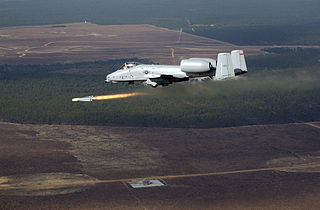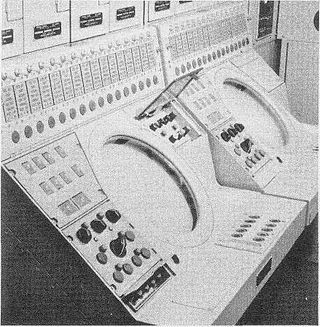See also
- Joint Electronics Type Designation System – Unclassified designation system for United States military electronic equipment
- List of military electronics of the United States
The Enhanced Position Location Reporting System (EPLRS) is a secure, jam-resistant, computer-controlled communications network that distributes near real-time tactical information, generally integrated into radio sets, and coordinated by a Network Control Station. [1] It is primarily used for data distribution, position location, and reporting. It enhances command and control of tactical units by providing commanders with the location of friendly units. [2] It was first fielded by the US Army in 1987. [3]
EPLRS is a Time Division Multiple Access System that uses a frequency hopping, spread spectrum waveform in the UHF band. [4] It incorporates the Thornton family of COMSEC devices, and has the capability for Over the Air Rekeying (OTAR). EPLRS uses the Army Data Distribution System version of the X.25 CCITT and IEEE 802.3 protocols to interface with Army Tactical Command and Control System (ATCCS).
Situation Awareness Data Link (SADL), [5] installed on USAF F-16 and A-10 fighters, coordinates with EPLRS for ground support missions. [6]
Each network is controlled by a Network Control Station (NCS), AN/TSQ-158. These have gone through several iterations.
Downsized version to fit in HMMWV, first fielded in 1991. Dimensions: 8.5'x7'x6', 4000 lbs
The AN/TSQ-158(V)4 is produced by Raytheon. Housed in a HMMWV replacing the AN/UYK-44 computer with a Toughbook laptop computer. Data is displayed through the FBCB2 platform.

The Joint Tactical Information Distribution System (JTIDS) is an L band Distributed Time Division Multiple Access (DTDMA) network radio system used by the United States Department of Defense and their allies to support data communications needs, principally in the air and missile defense community. It produces a spread spectrum signal using Frequency-shift keying (FSK) and Phase-shift keying (PSK) to spread the radiated power over a wider spectrum (range of frequencies) than normal radio transmissions. This reduces susceptibility to noise, jamming, and interception. In JTIDS Time Division Multiple Access (TDMA) (similar to cell phone technology), each time interval (e.g., 1 second) is divided into time slots (e.g. 128 per second). Together, all 1536 time slots in a 12-second interval are called a "frame". Each time slot is "bursted" (transmitted) at several different carrier frequencies sequentially. Within each slot, the phase angle of the transmission burst is varied to provide PSK. Each type of data to be transmitted is assigned a slot or block of slots (channel) to manage information exchanges among user participation groups. In traditional TDMA, the slot frequencies remain fixed from second to second (frame to frame). In JTIDS TDMA, the slot frequencies and/or slot assignments for each channel do not remain fixed from frame to frame but are varied in a pseudo-random manner. The slot assignments, frequencies, and information are all encrypted to provide computer-to-computer connectivity in support of every type of military platform to include Air Force fighters and Navy submarines.

Single Channel Ground and Airborne Radio System (SINCGARS) is a very high frequency combat network radio (CNR) used by U.S. and allied military forces. In the CNR network, the SINCGARS’ primary role is voice transmission between surface and airborne command and control (C2) assets.
The AN/USQ-17 or Naval Tactical Data System (NTDS) computer referred to in Sperry Rand documents as the Univac M-460, was Seymour Cray's last design for UNIVAC. UNIVAC later released a commercial version, the UNIVAC 490. That system was later upgraded to a multiprocessor configuration as the 494.

The Joint Tactical Radio System (JTRS) aimed to replace existing radios in the American military with a single set of software-defined radios that could have new frequencies and modes (“waveforms”) added via upload, instead of requiring multiple radio types in ground vehicles, and using circuit board swaps in order to upgrade. JTRS has seen cost overruns and full program restructurings, along with cancellation of some parts of the program.

The AN/MPQ-64 Sentinel is an X-band electronically steered pulse-Doppler 3D radar system used to alert and cue Short Range Air Defense (SHORAD) weapons to the locations of hostile targets approaching their front line forces. It is currently produced by Raytheon Missiles & Defense.

Hughes AN/TPQ-37 Firefinder Weapon Locating System is a mobile radar system developed in the late 1970s by Hughes Aircraft Company, achieving Initial Operational Capability in 1980 and full deployment in 1984. Currently manufactured by ThalesRaytheonSystems, the system is a long-range version of "weapon-locating radar", designed to detect and track incoming artillery and rocket fire to determine the point of origin for counter-battery fire. It is currently in service at brigade and higher levels in the United States Army and by other countries. The radar is trailer-mounted and towed by a 2+1⁄3-short-ton (2,100 kg) truck. A typical AN/TPQ-37 system consists of the Antenna-Transceiver Group, Command Shelter and 60 kW Generator.

The M1131 fire support vehicle (FSV) of the Stryker series provides automated enhanced surveillance, target acquisition, target identification, target tracking, target designation, position location and communications functionality. Targets will be transmitted instantly to the fire support system and shooter. Models with the double V-hull upgrade are known as the M1251 FSVV.

The AN/UYK-20 "Data Processing Set" was a ruggedized small computer manufactured by Univac and used by the United States Navy for small and medium-sized shipboard and shore systems built in the 1970s. It featured non-volatile magnetic core memory and was housed in a heavy-duty metal cube-shaped box which was designed to fit through a 25-inch circular hatch.

The AN/PRC-148 Multiband Inter/Intra Team Radio (MBITR) is the most widely fielded handheld multiband, tactical software-defined radio, used by NATO forces around the world. The radio is built by Thales Communications, a subsidiary of the France-based Thales Group. The designation AN/PRC translates to Army/Navy Portable Radio used for two-way communications, according to Joint Electronics Type Designation System (JETDS) guidelines.

Force XXI Battle Command Brigade and Below (FBCB2) is a communication platform designed for commanders to track friendly and hostile forces on the battlefield. It increases a vehicle commander's situational awareness of the battlefield by gathering information near real-time based on vehicle locations being updated on the battlefield. This information is viewed graphically, and exchanged via both free and fixed text message formats.

The AN/UYK-44 is the standard 16-bit minicomputer of the United States Navy. The AN/UYK-44 was developed in the early 1980s by Sperry Corporation and was completed in early 1984. The AN/UYK-44 was used in surface ships, submarines, ground C4I platforms, radar and missile control systems. The system was designed to replace the older AN/UYK-20 model.
The AN/UYK-43 was the standard 32-bit computer of the United States Navy for surface ship and submarine platforms, with the first unit delivered in October, 1984. Some 1,250 units were delivered through to 2000. The size of a refrigerator, it replaced the older AN/UYK-7, both built by UNISYS and shared the same instruction set. An enhancement to the UYK-43, the Open Systems Module (OSM), allows up to six VMEbus Type 6U commercial off-the-shelf (COTS) cards to be installed in a UYK-43 enclosure.
The AN/UYK-7 was the standard 32-bit computer of the United States Navy for surface ship and submarine platforms, starting in 1970. It was used in the Navy's NTDS & Aegis combat systems and U.S. Coast Guard, and the navies of U.S. allies. It was also used by the U.S. Army.

The Project Manager Force Battle Command Brigade and Below is a component of the Program Executive Office Command Control and Communications Tactical Special Projects Office in the United States Army. The phrase "brigade and below" in the name refers to the fact that operations and communications within these smaller Army units are shifting to a digital integration.

PM WIN-T is a component of Program Executive Office Command, Control and Communications-Tactical in the United States Army. PM WIN-T has been absorbed into PM Tactical Networks as Product Manager for Mission Networks.

The BCT network is a layered system of interconnected computers and software, radios, and sensors within the Brigade Combat Team (BCT) designed to increase survivability and strategy on a battlefield where units can communicate internally instead of through a central command. The BCT Network allows for a more efficient use of communication and a possibility to plug combined-arms warfare into the network for better communication.

Persistent Close Air Support (PCAS) is a DARPA program that seeks to demonstrate dramatic improvements in close air support (CAS) capabilities by developing a system to allow continuous CAS availability and lethality to Joint Terminal Attack Controllers (JTACs).

The Raytheon AN/MSQ-18 Battalion Missile Operations System was a Project Nike command, control, and coordination system for "each associated missile battery" to control a Nike missile as directed from a Raytheon AN/MSQ-28 at the Army Air Defense Command Post. Raytheon Company constructed the AN/MSQ-18 as 2 separate subsystems:
The Martin AN/TSQ-8 Coordinate Data Set was a Project Nike CCCS system for converting data between Army Air Defense Command Posts (AADCP) and Integrated Fire Control sites for missile Launch Areas. The AN/TSQ-8 in the Firing Unit Integration Facility (FUIF) was first installed for each Launch Area controlled from a Martin AN/FSG-1 Antiaircraft Defense System and then later for other Nike CCCS. The system included a "data converter, range computer, summing amplifier, status relay panel, status control panel, problem unit, [and] power control panel".
The Reeves AN/TSQ-96 Bomb Directing Central was an automatic tracking radar/computer/communications system. The United States Air Force used it from the 1960s, including during the Vietnam War.